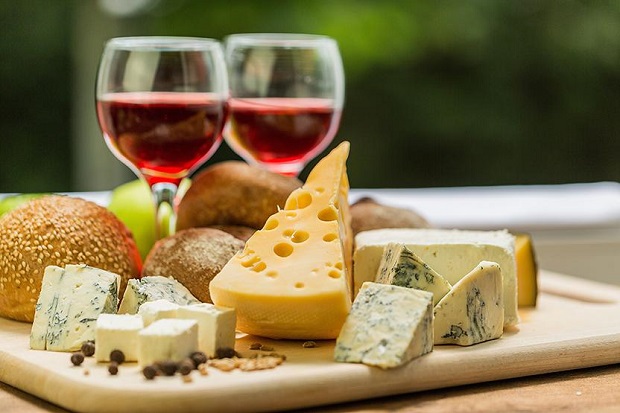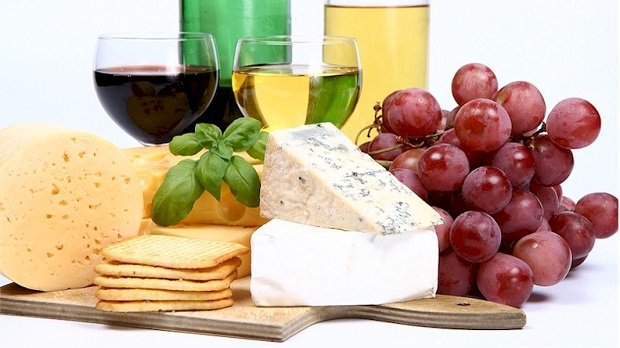
Know Your Cheeses
From super-sharp aged varieties to young fresh types, cheese can make all the difference to your antipasto lineup. Cheese runs the gamut of delicate to bold, much like wine, but with an intricate middle ground of surprising textures, aromas and notes.
As it ages, a cheese’s moisture evaporates leaving behind the most flavorful elements, protein and fat. This is why older cheeses tend to boast big flavor. Some of the characteristics an older cheese might develop: nutty and earthy (Parmigiano-Reggiano), gooey and rich (Brie) and irresistibly pungent (Gorgonzola). Young or fresh cheeses, like ricotta and chèvre, aren’t aged and are mostly mild with a soft texture. Fresh cheeses can be bright and citrusy or sweet and tangy. All of these flavors make for interesting pairings with your favorite wines.
Firm/Hard
Cheddar, Swiss, Parmigiano-Reggiano
A broad range of flavors and textures, firm and hard cheeses can be anywhere from sharp to earthy to mellow with a bite that ranges from elastic to hard with little moisture. The longer the aging, the more piquant and hard they become.
Pairs perfectly with big-bodied wines such as Malbecs and Cabernet Sauvignons.
Semi-Soft
Made with whole milk to create rich, buttery, mellow flavors and a pliable melt-in-your-mouth texture. Many semi-soft cheeses are infused with peppers or spices.
Pairs perfectly with medium-bodied wines like Cabernet Franc.
Fresh
Mascarpone, Ricotta, Feta, Chèvre
With no aging, fresh or unripened cheeses are typically moist with a soft, creamy texture and mild flavor. These cheeses are meant to be eaten quickly once made.
Pairs perfectly with lighter wines such as Sauvignon Blanc or Pinot Noir.
Blue
Stilton, Gorgonzola, Roquefort
Famous for its signature molding and marbling, blues vary greatly in texture and taste. These cheeses can be creamy, crumbly or dense with piquant, meaty or mild flavors.
Pairs perfectly with full-bodied wines like Merlot or Cabernet Sauvignon.
Soft (Bloomy Rind)
Brie, Camembert, Brillat Savarin
Ripened for a short period of time, bloomy rind cheeses are soft and creamy with a distinct white and fluffy rind, or bloom, boasting rich, earthy and buttery flavors.
Pairs perfectly with chardonnay or bubbly champagne.
Soft (Washed Rind)
Taleggio, Limburger, Epoisses de Bourgogne
These “stinky” cheeses are known for their pungent aroma, moist texture and big, meaty flavors. The orange-brown crust is typically not for eating, though, so stick to the flesh of the cheese, which ranges from oozy and runny to grainy and dense.
Pairs perfectly with other big flavors like strong oaky Rieslings and Pinot Noir.
Pair Cheeses with Wines of Like Intensity
Like cheese, wines boast a vast range of flavor and intensity. Younger lively wines inspire the palate with fruity and flowery aromas, On the other hand, wines that have spent time in casks or bottles typically develop a more complex flavor, with layers of toasty oak and earthy umami buried below its sweet and fruity exterior.
After what we discussed, it just makes sense … pair up your wines and cheeses by how bold or delicate they are. Robust red wines will overshadow the gentle presence of a mild and sweet Havarti. Likewise, a pungent cheese will overpower the delicate fruitiness of a sweet sparkling rosé.
Know Your Wines
Note on Dry vs. Sweet
Dryness or sweetness in a wine depends on its residual sugars, or natural sugars left after the grapes ferment. Fermenting begins with a very sweet grape juice that the yeast eats and ferments to create alcohol. If fermentation uses up all the sugar, the wine is considered dry. If fermentation stops before the sugar is used up, there will be more sugar, resulting in a sweet wine.
Reds (From Dry to Sweet)
Cabernet Sauvignon: Dry, powerful and full-bodied with notes of bold berries, plums and currants and sometimes hints of oak. Pairs perfectly with a bold cheese like extra-sharp Cheddar or heady blues.
Cabernet Franc: Medium-bodied with a low acidity and silky texture, defined by a soft aromatic fruitiness. Pairs perfectly with sharp hard cheeses like Manchego or aged Provolone.
Merlot: Medium to full-bodied with low acidity and a soft fruity aroma boasting hints of dark berries. Pairs perfectly with sharp cheeses like aged Asiago or Gouda.
Malbec: Full-bodied with notes of dark fruit, like blackberry and plum, nuanced with cocoa, leather and sometimes oak from aging. Pairs perfectly with rich and funky cheeses like Taleggio or a sharp aged Manchego.
Shiraz: (Also known as Syrah) big, bold and spicy with notes of dark fruits and a smooth finish, sometimes layered with a musky smoky aroma. Pairs perfectly with big-flavored cheeses like smoked Gouda or a peppery Pecorino.
Zinfandel: Medium-bodied red with pronounced fruitiness and spice. Pairs perfectly with other big flavors, like aged Cheddars and bold Goudas.
Pinot Noir: Delicate and fresh with notes of red fruit, like cherries and raspberries, sometimes owning earthier more complex flavors (due to aging). Pairs perfectly with classic aged cheeses like Gruyére or a Farmhouse Cheddar.
Whites (From Dry to Sweet)
Chardonnay: Dry, wide-bodied with rich citrus flavors, often fermented in oak barrels bringing a buttery—sometimes vanilla or toffee—tone. Pairs perfectly with fresh, creamy cheeses like Camembert and hard nutty classics like Parmigiano-Reggiano.
Riesling: Sweet as honey and best described as crisp, clean and aromatic with notes of fresh apples and lime. Pairs perfectly with tangy briny feta and pungent earthy washed-rind cheeses like Red Hawk or Drunken Goat.
Pinot Grigio: Dry, light-bodied with a fresh and fruity zest, boasting floral aromas and a touch of spice. Pairs perfectly with buttery Brie or creamy citrusy Homboldt Fog, a bloomy-rind goat cheese.
Sauvignon Blanc: Lively and with a bright acidity, a tropical fruitiness and herbaceous aroma. Pairs perfectly with tangy fresh goat cheeses and aged classics like Parmigiano-Reggiano.

Credits: Delallo, Vimbly, Inter Parish Ministry
